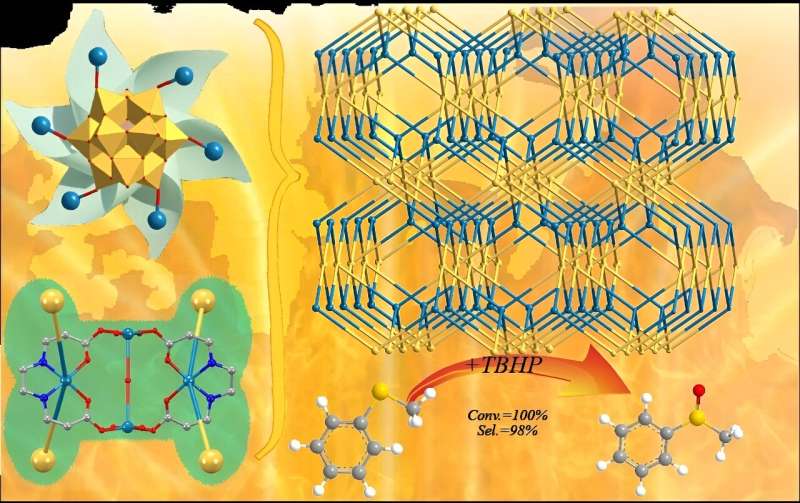This article has been reviewed according to Science X's editorial process and policies. Editors have highlighted the following attributes while ensuring the content's credibility:
fact-checked
proofread
Team synthesizes a new polyoxometalate-based metal-organic complex

A research team has synthesized a new polyoxometalate-based metal-organic complex that they then tested as a catalyst for the oxidation reactions of various sulfides. They found that the complex possesses excellent catalytic performance, good reusability, and structural stability.
The team's work is published in the journal Polyoxometalates.
Scientists in many fields have explored the selective oxidation of sulfides to sulfoxides. Sulfoxides are organic compounds that contain sulfur and oxygen. These sulfoxides are high value-added chemicals in pharmaceuticals, agrochemistry, dyes, and as chiral auxiliaries that are essential tools for building highly complex molecules.
The main way that scientists produce sulfoxides is by catalytic oxidation reaction of sulfides using homogeneous or heterogeneous catalysts and eco-friendly oxidants under mild conditions. So scientists are interested in the possibility of developing an effective heterogeneous catalyst with excellent catalytic activity and easy separation in catalytic oxidation reaction.
Polyoxometalates (POMs) are a class of nanomaterials that possess special features. These features include high negative charges, notable redox abilities and available organic grafting. Because of these features, POMs have attracted much interest in energy-related applications. Their potential applications range from material science, catalysis, medicine, environmental protection, and hydrogen production.
POM-based metal-organic complexes (POMOCs) are a growing branch of POMs. POMOCs not only combine the outstanding properties of POMs and metal-organic complexes, but also improve the leaching, dissolution and aggregation of POMs. They have been used in many areas, especially in catalysis.
"To our knowledge, there are only a few reported POM-based metal-organic complexes with a 3D framework based on POM units and metal-organic complexes bridges, prompting us to investigate this rarely explored research field. Because copper-organic complexes possess intriguing architectures, topologies, and applications, design and synthesis of new POMOCs with 3D framework based on POMs and Cu-organic complexes is still challenging," said Zhong Zhang, from the College of Chemistry and Materials Engineering, Bohai University.
In this research, the team obtained and characterized a new copper-incorporated POMOC called CuW-EDDP. This is a Keggin-type POMOC. Keggin-type describes the structural form of POMs. The Keggin-type and Dawson-type are two fundamental types of POM structures.
The team synthesized the CuW-EDDP under hydrothermal conditions that involved three days of heating in a stainless steel reactor, followed by cooling and drying. The team analyzed the CuW-EDDP they synthesized using infrared radiation spectra, elemental analysis, and thermogravimetry. They discovered that the CuW-EDDP features a unique three-dimensional structure. Furthermore, they found that that CuW-EDDP can be used as a heterogeneous catalyst for the selective oxidation of various sulfides.
From earlier studies, the team knew that POMOCs containing copper have exhibited excellent catalytic capability for many oxidation reactions, especially the selective oxidation of sulfides. This is because POMs and copper centers could act as catalytic active sites to promote the catalytic oxidation process. The abundant copper-active sites in CuW-EDDP promote its efficiency as a catalyst.
The team explored the optimum reaction conditions for the selective oxidation of methyl phenyl sulfide to methyl phenyl sulfoxide. They investigated the impacts of reaction temperature, CuW-EDDP dosages, tert-butyl hydroperoxide amounts, and solvent types. They carried out several different control experiments in the selective oxidation of methyl phenyl sulfide to methyl phenyl sulfoxide.
"As an effective heterogeneous catalyst, CuW-EDDP exhibited excellent performance, good reusability and structural stability in the selective oxidation of methyl phenyl sulfide. It displayed high conversion (100%) and selectivity (98%) within 30 minutes," said Zhang. The team also investigated the catalytic activity of CuW-EDDP toward the oxidation of other sulfide derivatives.
Looking ahead, the team is hopeful that the successful synthesis of CuW-EDDP can provide guidance to develop new POMOCs based on Keggin- or Dawson-type POMs and metal-organic complexes with novel topology and unique properties.
More information: Jia-Yu Sun et al, Hydrothermal synthesis, structure, and catalytic properties of a (4,6)-connected framework constructed from Keggin-type polyoxometalate units and tetranuclear copper complexes, Polyoxometalates (2023). DOI: 10.26599/POM.2023.9140039
Provided by Tsinghua University Press





















